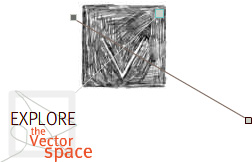Blue Velvet
Re-dressing New Orleans in Katrina's wake
Design by Erik Loyer
Author's Statement
Scholars in the Humanities have long labored under the conceit of the auteur mode of production. We are taught and reproduce the illusion that we produce our work alone, in isolation, thinking great thoughts pretty much on our own, in conversation if at all with the great works produced for the most part in this way. Composing Blue Velvet for this issue of Vectors was a stark reminder of how wrong-headed this picture largely is. The very idea for the piece came out of a conversation with Tara McPherson. It would look nothing like it does now but for the incredible design work of Erik Loyer and cartographic shaping and mediated elaboration enabled by Stefka Hristova. The final product is the outcome of intense weekly conversations over something like a year between the four of us about design, look, content, navigation, media, technological failures and fixes, in short, about New Orleans literally and metaphorically. But there were other inputs, exchanges, relations that helped make the piece come to life, from silent conversations with writers and artists who have felt the pulse of the Big Easy, in moments of health and illness, as well as with theoretical and political critics of neoliberalism. (For expressions of warm gratitude please consult Acknowledgment.) The sooner we get over the conceit of solipsistic self-production, the better off the Humanities will be.
But the process confirmed something more than this. Much of writing in the Humanities has tended to be linear. Without belittling the importance of this, the sort of multi-mediation that a vigorous digital forum such as Vectors makes possible shifts the linearity of rhetorical argumentation, rendering it less literal as it frees us from linearity. Vectors lives up to its name. It takes vectors seriously, encouraging connections, transversals, relationalities. The form encourages a writing that is more fragmentary without being self-contained, open to play across dimensions, to interactivity between media, to a different kind of complexity. To mixing and mashups, made and remade.
The stress on metaphoricity consequently becomes crucial. There is, as Godard once remarked, a beginning, middle, and end, but never quite in that order. One can begin again and again, and almost anywhere; while ending one's session with the material as one sees fit. So the writing—better, the composing and orchestration because it is never simply writing in such a forum—is in constant play with the reading, whether concretely or as possibility. So the medium loosens the sense of absolute control. It is as if the material writes you, rather than the reverse. The experience has been liberating, as much from the literality of the linear within the narrow constraints of one's own writing as from the tyranny of the narrowly textual more broadly.
But then New Orleans will tend to have that effect on one too.



